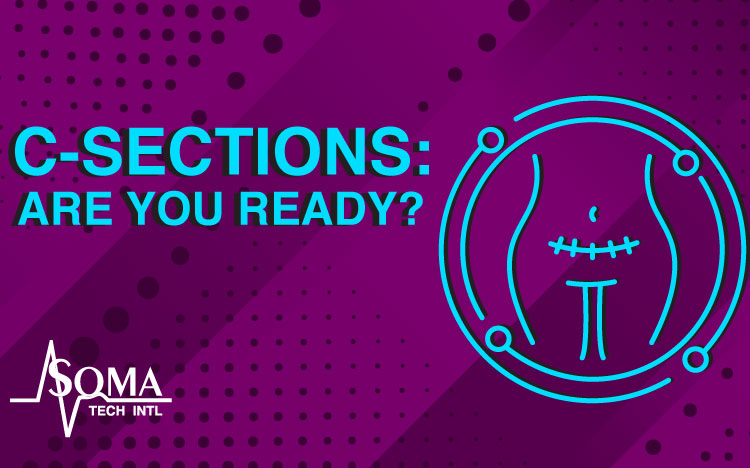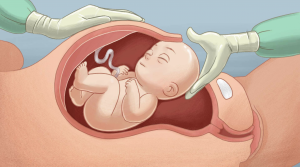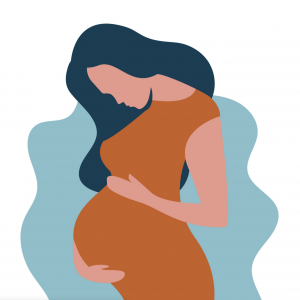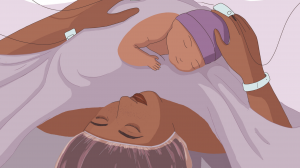C-Sections: Are You Ready?
April 4, 2023
Bringing a child into this world can be one of the most rewarding experiences, but with that comes several questions about birthing. April marks the start of Cesarean Awareness Month, where we will give you all the facts you need to know about C-section births.
What is a C-Section?
C-Sections are used to deliver a baby through surgical incisions made in the abdomen and the uterus. While vaginal births are more common, C-section births make up one-third of all births and this number keeps increasing. For some pregnancies, C-sections can be planned ahead of time because of complications with the pregnancy. However, it is not always clear if you need this procedure until you are in labor, which is also known as emergency C-sections. If you are pregnant, knowing what to expect during this procedure can help you prepare if you need one. While C-sections can be necessary in some cases, vaginal births are still recommended since this procedure has a few risks. If you are expecting a child, it is best to talk to your healthcare provider to see the option that is best for you and your baby.
When Are C-Sections Needed?
- Labor is not progressing normally. This includes issues with prolonged labor in the first stage (prolonged dilation of cervix) or the second stage (prolonged time of pushing after cervical dilation).
- If the baby is in distress. If the baby has changed in its heartbeat, C-sections might be the safest option for you and your child.
- If the baby is in an unusual position. If the baby has not positioned itself head-down when you are in labor, C-sections are the safest way for them to be delivered.
- If you are carrying more than one baby, a C-section might be needed for a set of twins or more. This is crucial especially if labor starts too early or the babies are not positioned correctly.
- If there is an issue with the placenta. If the placenta is in front of the cervix, the doctors might suggest a C-Section for easier delivery.
- Certain health conditions that affect the mother can make a C-section safer.
- If there is any type of blocking, whether it is a fracture or if the baby cannot fit through the birth canal, C-Sections might be necessary.
- If you have had a previous C-Section or other surgeries in your uterus, a C-Section might be recommended by a doctor.
Risks of a C-Section
While a C-Section can be extremely helpful for women having children, this is not the best option for women who want to have multiple children. The risks become higher with the more C-Sections a woman has and there could also be problems with future pregnancies. Emergency C-Sections are necessary for the health of the mother and the baby but talk to your doctor if a C-Section is necessary for you and what options are available that best fit your health. Here we will list a few more risks that come along with a C-Section.

Risks for the Baby:
- Breathing problems can occur (transient tachypnea) that causes the baby to breathe too fast for a few days after a C-Section birth.
- There could be some injuries due to the surgery. This is exceedingly rare, but accidental nicks to the baby’s skin can happen when performing the surgery.
Risks for the Mother:
- Infection after surgery. There is a risk of developing an infection on the incision of the uterus or a urinary tract infection can also develop.
- Blood loss because of a C-section. This procedure might cause heavy bleeding during and after the delivery of the baby.
- Reaction to anesthesia. To perform a C-Section, the mother must be given anesthesia. Make sure to discuss possible issues your body might have with anesthesia based on past medical history.
- Blood clots can develop. C-Sections increase the chances of developing a blood clot in the legs or pelvis, and if the blood clot travels to the lungs, it could be life-threatening.
- Injuries due to surgery. While surgical injuries are rare, they can still occur in the bladder and bowel.
- Increased risks for future pregnancies. While it is still possible to give a vaginal birth even if you have had a C-section previously, you risk tearing your uterus from a previous C-Section. Having a C-Section also increases the risk of complications in later pregnancies and developing placenta accrete (a condition where the placenta becomes attached to the uterus wall).
What to Expect During a C-Section
- Before the procedure, you will receive anesthesia, such as an epidural or spinal block. Usually, you will be awake for the procedure, but if it is an emergency, you will receive general anesthesia, which means you will fall asleep.
- They will place a drape on your abdomen to keep you from seeing the incision, but you will be able to see the doctors and nurses. At this point, the person you brought with you will be moved closer to your head to give you support through the surgery.
- The initial incision is then made on the lower abdomen area. The incision is almost always horizontal, while vertical incisions are only used in cases of emergency.
- The surgeon must go through multiple layers before reaching the baby. They cut through the skin, fat, abdomen, and finally the uterus. They may also need to push aside their bladder and intestines to better reach the baby.
- When the surgeon reaches your uterus, you will hear a suctioning noise. The amniotic fluid will be suctioned away to facilitate the removal of the baby.
- Depending on how your baby is positioned will determine how the baby is pulled out. Usually, they are in a head-down position, therefore their head comes out first and their body follows.
- When the baby is being taken out you will feel some tugging and pulling; however, you should not feel any pain. The anesthesiologist will also be in the room to make sure you feel no pain or if you need a higher dosage.
- The baby will need a little extra help during a C-Section, so they will suction the baby’s nose and mouth for fluids. (In a vaginal birth these fluids are squeezed out by the constriction of labor.)
- Once your baby is born, the doctors will cut the umbilical cord, you will be shown your baby briefly, and then they are taken aside for basic care or placed in a warmer.
- After this, the placenta will also be delivered, and your surgeon will check to make sure everything is safe.
- Closing up the incision is the longest part of the surgery, taking anywhere from 30 minutes to an hour. However, you can enjoy your baby (if desired) and can hold and breastfeed them. Your partner can also hold the baby during this time.
- There are several ways to close the incision. The uterus is closed with dissolving stitches while the outside layer is closed by either staples or stitches depending on what works best for you. Then the incision will be covered with a bandage.
- While you recover, you will be watched for a few hours to make sure your vitals are healthy, and then you will be moved to your postpartum room. There you will be able to spend time with your baby and partner and the doctor will tell you about the next steps in your recovery from surgery.
After Surgery
There can be very mixed emotions about C-Sections. Some people are nervous, scared, and anxious and this is all normal. There is also a huge shift in hormones and of course body trauma that needs to heal after giving birth. If you are disappointed about having a C-Section, remember that this procedure was done because it was the safest option for you and your child. There is no shame in how your child was birthed, the important thing is for you and your child to be healthy after an experience this big. Share your feelings with your partner, family, and even your health provider. (If you have feelings of sadness that last over two weeks, tell your provider as this may be a symptom of postpartum depression.)
Explore Other Blog Items By Category
Recent Posts


EKG vs ECG | What’s the Difference Between ECG and EKG?




